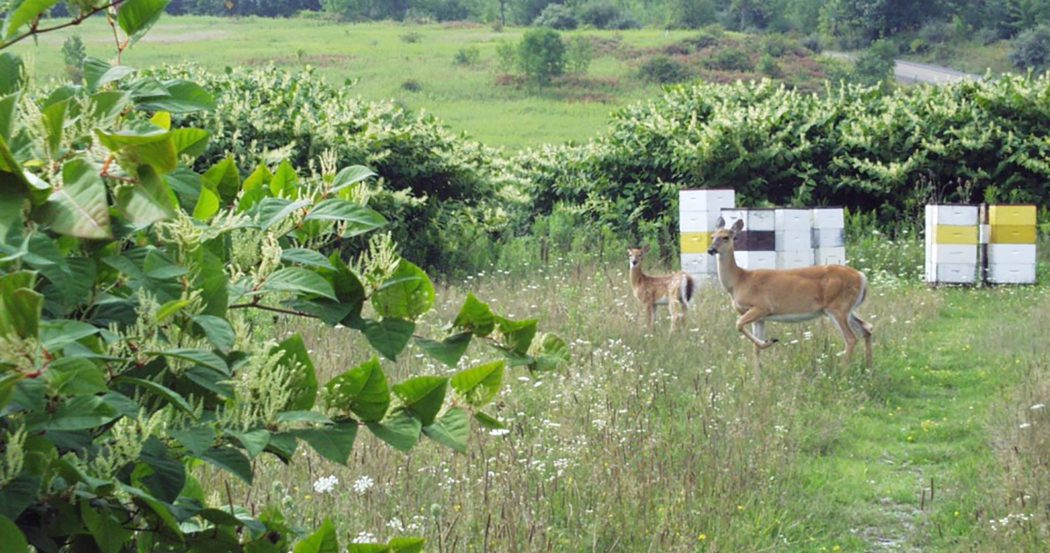Part 1: Honey Plants Differ Greatly in Growth and Nectar Production Depending Upon the Soils in their Locality
By: Michael Johnston
Strangely enough, it is not intuitive to most beekeepers that soil types are extremely important to how well their beehives will produce honey as well as what types of honey will be produced. Our expectations of honey crops depend upon our own past experience or a verbal legacy passed down from more experienced beekeepers.
Beekeeping is a form of agriculture. While it is obvious to all of us that soil fertility and pH are vitally important to field crop production, we often do not make the connection that beekeepers are producing a crop dependent upon plants that either will or will not thrive depending upon the soil in which they are grown. I suspect that if our job as beekeepers was more involved with the production of honey plants rather than the production of bees, the connection between soils and honey crops would be more obvious.
In the literature on beekeeping, you do see references to the importance of soils in apiculture. One such book, Honey Plants of North America written by John H. Lovell and published in 1926 does identify the importance of soils in beekeeping.
Mr. Lovell states “Plants growing in soils to which they are adapted are more vigorous and produce more nectar than in soils in which they do not flourish.” In his section on New York State, Lovell says “New York well illustrates the importance of a knowledge of soil properties not only to the farmer but to the beekeeper as well.”
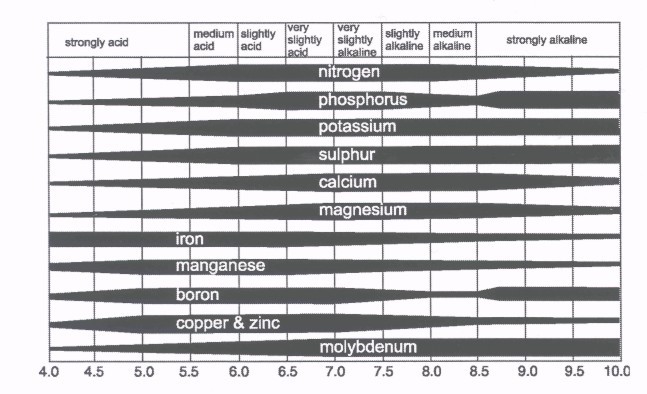
Chart of the Effect of Soil pH on Nutrient Availability
Soil fertility, the availability of needed plant nutrients, will lead to more vigorous plants. Natural soil fertility is dependent upon texture, organic matter, pH, soil depth and the parent material from which soil is derived. The pH of a soil is directly related to the availability of soil nutrients to plants. The term pH refers to the proportion of hydrogen ions (H positive) and hydroxyl ions (OH negative) in water (H2O) solution. The measurement scale for pH is logarithmic and goes from zero to 14 with seven being neutral. Soils with a pH under seven are acid and hydrogen ions are predominate and soils over seven pH are basic and hydroxyl ions are predominate. Most soils are acid and can be described as follows:
- 6.5 to 7.2 – slightly acid to slightly alkaline
- 5.5 to 6.5 – moderately acid
- 5.5 and below – very strongly acid
A pH between six and seven correlates to the greatest availability of nutrients in soil solution. Nitrogen is most readily available in soils greater than 5.5 while phosphorus, potassium, calcium and magnesium are more readily available in soils with a pH greater than 6.0. Molybdenum is very unavailable in acid soils and becomes readily available in soils with a pH greater than 6.5. Molybdenum is particularly important to growth of plants in the legume family. When the pH goes above 7.0, the availability of phosphorus, zinc and copper decline rapidly. Iron and manganese are necessary micronutrients for plant growth but when the pH of soil drops below 5.5, there can be so much of these nutrients as well as aluminum in solution that they actually become toxic to many plants.
In Honey Plants of North America, John Lovell separates honey plants into two great groups: Calciphiles (lime lovers) – plants which grow best in limestone (sweet) soils with a relatively high pH and Calciphobes – plants which avoid lime soils and grow best in acid (sour) soils. In regard to the calciphiles, he further states some plants grow in high lime soils only, while some prefer lime soils but will grow in other soils. Similarly with the calciphobes, some plants will grow in acid soils only, but some prefer acid soils but will grow in other soils. There are still other honey plants that will yield on a wide range of the pH scale. We will review some examples of all of these groups.
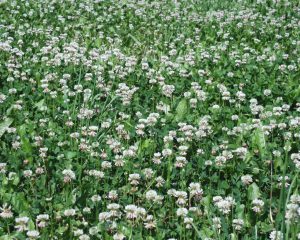
White Clover (Photo by Peter Borst)
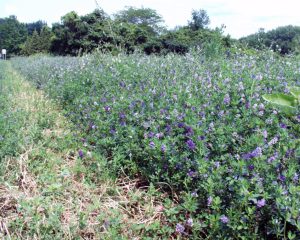
Alfalfa (Photo by Peter Borst)
The Leguminosae (Fabaceae) is the most important plant family for beekeeping in North America and many of its members are calciphiles. Legumes are extremely important to agriculture and are a basic element of crop rotations. Members of the legume family include alfalfa, white clover, sweet clover, alsike clover, vetch, black locust, peanuts, lupine, acacia, mesquite and redbud. The legume family has 18,000 species and is the third largest family in the angiosperms. Alfalfa and the clovers have a very strong affinity for soils with a relatively high pH. This is due to their high demand for nitrogen and these plants can actually be grown on soils with a low pH if supplied with large amounts of nitrogen fertilizer. The legumes are famous for their symbiotic relationship with nitrogen fixing bacteria (a.k.a. rhizobia) located in nodules on their roots. Different species of rhizobia are specific to different legumes (with some exceptions). These bacteria will not grow in acid soils because the micronutrients molybdenum, copper and cobalt are required for enzymes used in the nitrogen fixation process. The nitrogen fixing bacteria are even more sensitive to a low pH than the legumes that it supplies with nitrogen.
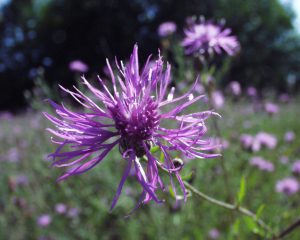
Spotted Knapweed (Photo by Peter Borst)
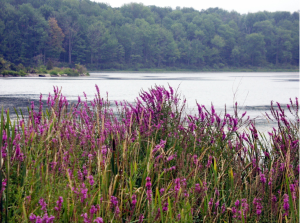
Purple Loosestrife (Photo by Peter Borst)
Some examples of plants that prefer high lime soils but will grow in other soils include spotted knapweed and purple loosestrife. Both of these plants have been spreading throughout New York State, where I live. In areas with high pH soils, these two plants (along with white clover and basswood) contribute to a sustained honey flow that begins in early July and continues through the end of August. Though knapweed and loosestrife are now common in areas with acid soils south of here; beekeepers there still report a dearth from mid-July until goldenrod starts blooming in the middle of August. So these two plants grow on these acid soils but do not produce much nectar there.
The greatest examples of calciphobes are plants that belong to the Ericaceae, another very important family of honey plants. Included are blueberry, cranberry, Manzanita and madrone in North America. Common heather or ling in Great Britain is also in the Ericaceae. All grow in strongly acid soils. For example, blueberry prefers a range of 4.2 to 4.8 pH. These plants rely on their association with mycorrhizae to obtain nutrients that are not readily available in acid soils. Mycorrhizae are ground fungus that are symbiotic with the roots of most plants. Their mycelium reach further than the root hairs of plants and being a fungus, they break down the organic matter present in soil. While the mycorrhizae supplies nutrients, the plant repays with sugars and carbohydrates.
Mycorrhizae translates to fungus root and refers to the association between plant roots and soil fungus.
More than 90% of plant species studied have a symbiotic relationship with mycorrhizal fungi. There are many species of mycorrhizal fungi. Some are associated with only one plant species, while others will work with many species of plants. Some plant species will not survive without mycorrhizae, while others benefit but can live without it.
Soil scientists in the United States realized the importance of mycorrhizae when tree plantings failed in the Midwest during the 1930’s. These plantings were meant to reduce wind erosion during the dust bowl era. These plantings were made in soil devoid of the proper mycorrhizae.
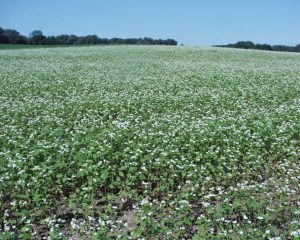
Buckwheat (Photo by Peter Borst)
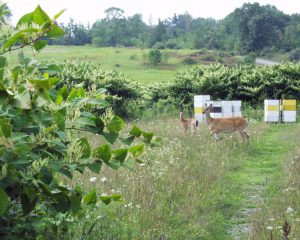
Japanese Knotweed (Photo by Peter Borst)
Famous calciphobes that prefer moderately acid soils but will grow on higher pH soils include goldenrod (Composite family) and buckwheat (Polygonaceae) and japanese knotweed (Polygonaceae). It is common enough to see goldenrod on high lime soils. It does yield some nectar and there is the associated odor from hives making goldenrod honey. Because of its low yield, a saying among beekeepers with hives on high lime soils is “you can smell goldenrod honey but you can’t see it”. In a similar manner, buckwheat will yield some nectar on high lime soils but prefers moderately acid soil. A few years ago, I had bees placed near hundreds of acres of buckwheat growing on high lime soils; unfortunately the bees only brought in enough buckwheat to slightly darken my nice light honey.
While it is a useful generalization to classify honey plants as calciphiles or calciphobes, the plant world is not just black or white. There is a continuum of plants with preferences to pH. While there is variation in pH’s of soil across the landscape, there are plants that have developed that are adapted to those environments. The accompanying table from Purdue University (right) shows how different crop species are adapted to a wide range of pH. It is interesting to note that there is some overlap between the optimum pH for buckwheat and many of the legumes so there will be some locations where both will yield honey crops.
While much of this article has focused on soil pH, there are many other soil factors (edaphic factors) affecting plant growth. Among these factors are texture (the proportion of sand, silt and clay), soil profile and depth, parent material, organic matter and soil organisms, structure, porosity, moisture, soil air, topographic location and soil fertility (either natural or from the fertilizer bin). Environmental factors such as extreme temperatures, humidity, aspect, wind, day length and fire may affect plant growth and honey production more than soils. Biotic factors such as plant competition, disease and herbivores can also affect plant growth more than other factors.
Some honey plant species have an optimum pH for growth and nectar production in the range of 6.5 to 7.0 but still there are significant honey plants in areas outside of this pH range. Growth and honey production are limited more by some of the aforementioned soil, environmental and biotic factors. Some examples are thyme, basswood, black locust, tulip poplar and sugar maple.
Wild thyme, a member of the mint family (Lamiaceae), is an introduced plant in New York and is well known as a honey producer on high lime soils south of Albany as well as lower pH soils in the Catskills. Thyme prefers well drained soils, is drought tolerant and does best in full sun. Another famous mint is sage, also known as salvia. There are as many as 18 species of sage in California, the most notable being black sage. Sage can be found growing in soils with pH ranging from 4.0 to 8.0. It is very drought tolerant and prefers well drained soil. It will not persist in soils that are continually wet.
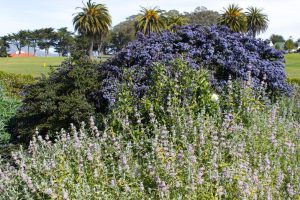
Black Sage with California Lilac in background (Photo by Peter Borst)
California Lilac (Ceanothus spp.) grows on acid or alkaline soil, thrives in full sun and well drained soil but benefits from moderate to heavy rainfall. There are many varieties (or species depending upon whether you are a splitter or clumper) of this plant in coastal mountains of California. Some varieties produce surplus honey while others are worked more by bumblebees. The Ceanothus is one of six genera of the 55 genera in the Rhamnaceae (Buckthorn) family that have nitrogen fixing bacteria on root nodules similar to legumes (Fabaceae).
Black locust is a member of the legume family. Before the primeval forest was cleared by European settlers, the original range of Black Locust was restricted to areas with high pH soils in the central Appalachians. Since that time black locust has been widely planted because of its resistance to fungal rot and its use as fence post material. Fortunately for beekeepers, this legume yields nectar everywhere it is grown. We can infer, though, that it probably yields nectar better in high lime soils similar to its natural habitat.
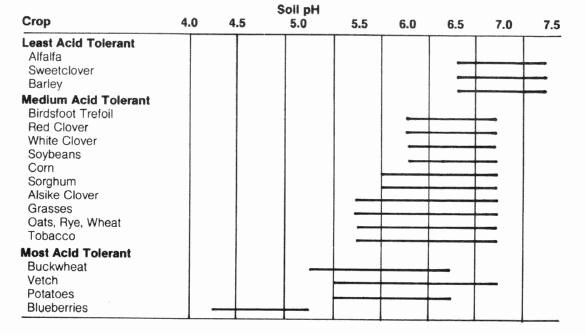
Range of pH Tolerances for Different Crops (Purdue Forage Information)
Tulip poplar, a member of the Magnolia family, will grow on soils with pH ranging from 4.5 to 7.5. It does prefer deep soils that are moderately moist but also well drained.
Sugar maple is a good honey and pollen plant in very early Spring. The pH range for growth is 3.7 to 7.9 but does best in the range of 5.5 to 7.3 pH. According to a U.S. Forest Service fact sheet, it will typically comprise 52% of a mature stand of trees in New York but only 17% of a mature stand in Minnesota and Wisconsin.
It will grow in a wide variety of soils and its range extends from northern Canada to the Gulf Coast. It can tolerate a minimum temperature of negative 46 degrees Fahrenheit. It is not a wetland plant. The greatest limit to its range is droughtiness. It is a shade tolerant tree but will be out-competed by more rapidly growing species such as white ash or black cherry in full sun.
Basswood will grow on soils ranging in pH from 4.5 to 7.5. It reportedly does best when the pH is in the 6.5 to 7.0 range, but large honey crops have been obtained from basswood in areas with acid soils. The range of this plant is very similar to the range of sugar maple and is closely associated with it. It is not quite as shade tolerant as sugar maple. It is a nitrogen demanding species. It is limited by droughtiness and grows better with a north facing or east facing aspect.
So how are some honey plants affected if we just consider soil texture? The optimum soil texture for agricultural crops is referred to as a loam. This is a mixture of the three soil size particles: sand, silt and clay. While sand is helpful in providing drainage, it is not a good source of nutrients. Clay particles are a good source of nutrients but a heavy clay soil is a difficult medium for the growth of plant roots. Silt is intermediate in qualities between sand and clay. Our most important honey plants in the legume family are adapted to a wide range of soil textures. While the optimum texture for alfalfa and sweet clover is a loam, they will also grow and yield honey on all soil textures. White clover will do well on clay or loam soils. Asters (composite family) will do well on soils ranging from sand to clay. Goldenrod (composite family) does well on clay soils. So, soil texture in many cases will not determine what plants will grow on a site. Optimum soil texture will promote optimum growth and vigor of plants.
Admittedly, this article is only scratching the surface of the relation between soils and honey production. There are many more honey plants and environments to consider beyond the scope of this article. For each habitat with different qualities, there have been plants that have adapted to grow there. It is up to the beekeeper to learn the qualities of the habitat where their bees are placed and what plants grow in that particular area. A good start to learning about your situation would be obtaining a copy of Honey Plants of North America by John Lovell (it can be found at Bee Culture’s Bookstore: https://store.beeculture.com/1926-honey-plants-of-north-america/). While this article is an introduction to the subject, Mr. Lovell wrote a whole book about it.
In the next article, we will focus on how different soil types influence honey production. The USDA Soil Conservation Service (now Natural Resource Conservation Service) has done a lot of valuable work mapping and explaining the soils of the United States. With this information, it will be apparent why there are great concentrations of commercial beekeepers in certain areas while not so much in others. For the non-migratory beekeeper, a knowledge of soils may be useful in finding better locations not far from home as well.






